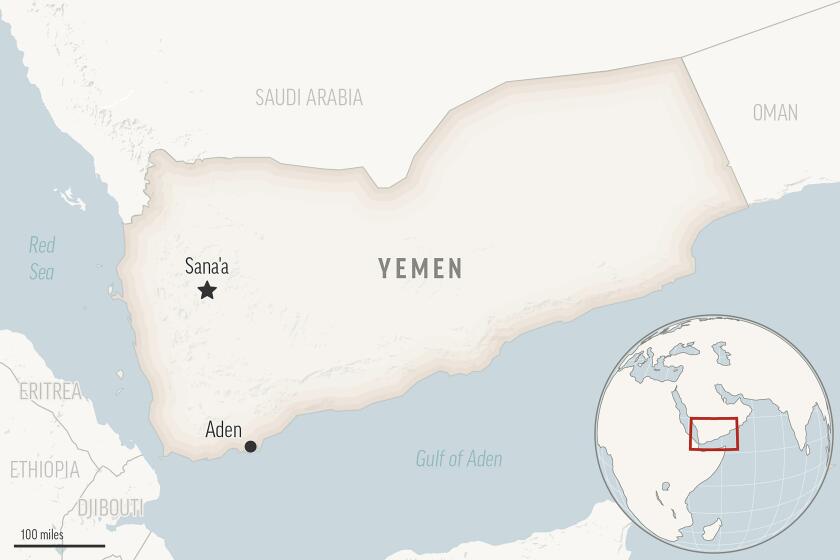On Hezbollah’s TV channel, anti-U.S. news at 10, 11, 12 . . .
- Share via
BEIRUT — Wearing a bright blue veil carefully wrapped around her head, the TV host smirked as she listened to her guest’s comments about the lack of U.S. strategies in the Middle East.
“The U.S. administration has no policies,” U.S. analyst and military expert Mark Perry said recently on the only English-language talk show on Hezbollah’s TV station, Al Manar. “It is not that it has bad intentions, but [that it] has no intentions.”
The 33-year-old presenter, Zaynab Assafar, thumbed through her notes. In fluent and elegant English she quickly asked about the relationship between the U.S. and Israel, the future of peace talks and the prospects of a strike against Iran.
For the last year and a half, Assafar has been interviewing people such as Western intellectuals critical of Zionism, a former U.S. ambassador to the region and Irish peace activists. Her weekly program, “In Their Eyes,” is part of Al Manar’s attempt to broaden its global reach after Hezbollah’s war with Israel in the summer of 2006.
“We started after the victory of 2006. We wanted a wider scope of people to discuss the regional implications and repercussions of this tremendous happening,” Assafar said. “Our message has not changed. We are reacting to Israeli activities against us and exposing the consequences of the U.S. administration’s full support to the Israeli entity.”
Assafar’s program is just one in a hodgepodge of talk shows, news bulletins and promotional clips that daily lambaste U.S. tactics in the region, including the military presence in Iraq and the nuclear standoff with Iran.
“Al Manar is very powerful in manipulating public opinion by using all the modern tools and techniques of propaganda,” said Lawrence Pintak, director of the Center for Electronic Journalism at American University in Cairo. “As a mouthpiece for a political movement, it is one of the most effective TVs in the Middle East.”
Al Manar, which calls itself the “Station of the Resistance,” began broadcasting in 1989. The Shiite Muslim militant group Hezbollah regards it as part of the “psychological warfare” against Israel. But in addition to news and political programs, the channel broadcasts health and family programs, entertainment shows, educational programs for children and video clips glorifying the group’s “martyrs.”
Besides its domestic role of propagating and consolidating Hezbollah’s ideas, Al Manar has increasingly focused on regional issues, especially in the Palestinian territories, since the addition of its satellite channel in 2000. That emphasis coincided with the withdrawal of Israeli troops from southern Lebanon, seen by Hezbollah as its first major victory.
The U.S. State Department listed the station as a terrorist organization in 2004, when Al Manar was accused of anti-Semitism for airing a controversial series about the Jewish diaspora. It was banned in North America and other locations. But since 2005, Al Manar can be viewed anywhere in the world through its website, which is in Arabic and English, and where viewers from various regions post comments.
The bans stirred a debate at Al Manar regarding its editorial line and led to the adoption of some rules, said Olfa Lamloum, a researcher specializing in Arab media at the French Institute of the Near East in Beirut.
“Al Manar has readjusted certain things since 2004. It was decided that the channel should adopt a position against the U.S. policies and not the American people,” Lamloum said.
“Images such as those showing disrespect to American values were removed from air. We stopped seeing crowds stepping [on] and burning the U.S. flag or a clip showing the Statue of Liberty with tears of blood.”
Likewise, a clear difference was drawn between Judaism and Zionism. On Al Manar today, reporters refer to Israel as the “Zionist entity” and never the “Jewish state.”
Al Manar also respects sensitivities in the Arab region. Its satellite channel has much less religious content than its broadcast station, to appeal to mostly Sunni Arab audiences. Even the call to prayer, different between Sunnis and Shiites, is not aired regionally. Although female presenters wear head scarves on the air, female guests are not necessarily veiled.
“Al Manar is widely viewed and respected in the Arab region,” said Nabil Dajani, media professor at American University of Beirut. “The station adopts a wise policy that makes them popular. They don’t attack Arab regimes, and they don’t preach their religious ideology.”
Just as Al Jazeera emerged as a major pan-Arab channel in the 1990s after the Persian Gulf War, Al Manar captivated Arab viewers during Hezbollah’s war in 2006 by covering the conflict closely. It was also the target of an Israeli attack that destroyed its premises in the southern suburbs of Beirut. Despite the incident, Al Manar resumed its broadcast from a secret location within seconds.
The station’s viewership increased significantly that year -- Al Manar ranked fifth as a source of news in the Arab region, according to some studies.
In March, as Syria prepared to play host to the annual Arab League summit, Al Manar led a campaign to bolster the image of that neighboring country as one of the pillars of resistance to U.S. policy in the region.
In the opening of its news broadcast the day the summit started, the TV presenter declared: “It’s the summit of the decency which thwarted the [U.S.] project for the ‘new Middle East.’ . . . It’s the summit of crossroads, the summit of Arab defiance . . . of rejection to U.S. interference.”
More to Read
Sign up for Essential California
The most important California stories and recommendations in your inbox every morning.
You may occasionally receive promotional content from the Los Angeles Times.













